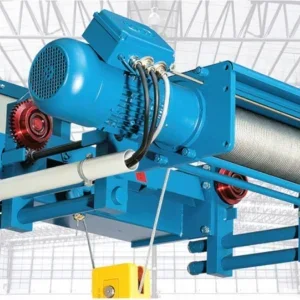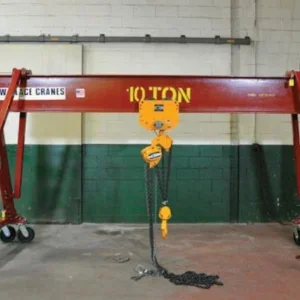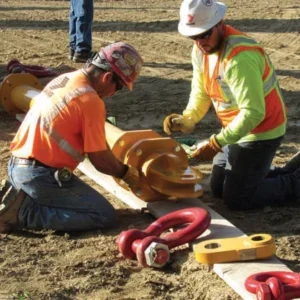Given that the lifting industry has always served a diverse range of sectors, it is perhaps no surprise that its fortunes over the past fifteen years very much seem to have reflected trends in the wider economy. So whilst there have been any number of significant changes and developments since the launch of Hoist magazine back in 1998, perhaps the most dramatic could loosely be categorized as ‘globalization.’ An industry once clearly defined by national boundaries has certainly taken on an increasingly international outlook and, for many of us in the industry, the story of the past decade and a half has been one of a rapidly shrinking world.
When the term globalization is used, it’s usually in the context of the shift in volume manufacturing to low wage economies in Eastern Europe or Asia. And there’s no doubt that this has been a major characteristic of the lifting equipment industry in recent years.
Particularly in the early stages, there was much debate over the implications in terms of the quality and integrity of the products manufactured in emerging economies. For some, these concerns persist. But whilst it has always been impossible to generalize about the standards being achieved in one country or another, there is no doubt that the arrival of a genuinely global market place – fuelled by the rise of the Internet – has placed greater emphasis on the need for vigilance amongst buyers. Choice may have multiplied and, in many cases, prices fallen, but at the same time the robust specification of lifting equipment has never been more important.
This increasingly international perspective has also shaped the legislative framework. Perhaps it was not by chance that the launch of Hoist coincided with the introduction of the Lifting Operations and Lifting Equipment Regulations (LOLER) in the UK. Marking the end of a ten year transition from UK-based legislation to a health and safety framework based around European directives, LOLER has had a significant impact. The LEEA has always supported its emphasis on the need to undertake periodic thorough examination of all lifting equipment and use competent personnel for every aspect of lifting operations. But whilst 15 years on it is still easy to point out shortcomings in terms of how some employers respond to these key requirements, it would be wrong not to highlight the sensible and positive contribution it has made to the safety and professionalism of the lifting industry overall.
This positive view of LOLER’s impact is shared by some other important stakeholders. Notably, LOLER appears to have emerged unscathed from the review of health and safety legislation undertaken by Professor Löfstedt on behalf of the Coalition Government that came to power in 2010. Given the high priority the administration has placed on reducing the burden of health and safety legislation, this is a fairly weighty endorsement of LOLER’s commonsense approach.
More evidence of LOLER’s significance has been provided by the willingness of companies working outside the UK to adopt it as best practice for their overhead lifting operations. Typically this is an approach taken by organizations working in parts of the world that lack sectorspecific health and safety legislation.
LOLER is generally the preferred choice to fill the vacuum and the cumulative effect has been to steadily extend the influence of this particular piece of legislation right around the world.
The widening adoption of LOLER also highlights another positive trend within the industry over the past fifteen years: a growing recognition of the need for greater professionalism. Right across Asia, the Middle East, Africa, South America and Australasia, numerous countries have experienced dramatic economic growth. Many of the industries behind this, such as oil, gas and mineral extraction, heavy manufacturing and construction, are hugely dependent on overhead lifting.
However, the health and safety infrastructures within these countries have often struggled to keep pace and employers and government agencies alike have identified the need to seek specialist support from overseas. At the LEEA this has been reflected in a truly remarkable increase in membership from countries based outside the UK. Back in 1998, LEEA membership stood at less than 150.
Fifteen years on, that figure has risen to over 650, of which around half are located in countries other than the UK.
Significantly, the main motivation has been access to the training, qualifications, accreditation and expert advice that membership provides. Over the same period, the LEEA has also found itself working with a growing number of government bodies and agencies that are seeking to implement more effective regulatory frameworks for overhead lifting.
Of course one of the consequences of the emergence of the LEEA as a truly international association is to add further momentum behind the trend towards common standards and practices in the global lifting industry. Every year, hundreds of engineers around the world are sitting the same Diploma examinations set by the LEEA. The Association’s TEAM card registration and identity scheme is equally international in outlook, now encompassing engineers based in 34 different countries. And the LEEA’s User’s Pocket Guide has now been translated into languages that include Portuguese and Arabic, with a Chinese version currently in development.
Whilst the LEEA’s activities tend to focus on human competencies, it is equally easy to identify convergence in the design and manufacture of the equipment. For example, the past fifteen years have seen Harmonized European Standards play an ever more important role. In the EC, these have a quasi-legal status, in that a product which genuinely conforms to the relevant standard is deemed to meet the essential health and safety requirements of the Machinery Directive. As such, it represents a near watertight means of guaranteeing quality.
Consequently, these high quality practical standards have been widely accepted not only within Europe, but throughout the world. Furthermore, they are now being extensively used as the basis for the next generation of International Standards (ISO).
There can be little doubt that the momentum behind this international convergence will continue. As has been stressed, much of it reflects positive trends. The overwhelming impression from the LEEA’s perspective is of an industry that is striving hard to improve standards and professionalism and reduce the needlessly high level of accidents that still blights the industry. But there are also some serious issues ahead. An uncertain economic climate and fierce competition inevitably puts pressure on prices and margins. The desire to cut corners must always be resisted, and the industry should never miss an opportunity to stress the economic value of properly planned and executed lifting operations. Another on-going problem is the worldwide shortage of suitably qualified and experienced lifting equipment engineers; as more countries recognize the importance of using appropriate staff then this skills gap is only set to widen. Clearly the LEEA has an important role to play in tackling this. Much work has already been done in terms of increasing the Association’s training capacity over the past few years, but the extraordinary rise in demand shows no sign of abating. More still needs to be done. Indeed the LEEA will no doubt face many such challenges over the next fifteen years. However, if there is one reason above all else to be optimistic for the future, it is the willingness of so many members to continue to work together in the best interests of the industry as a whole.






